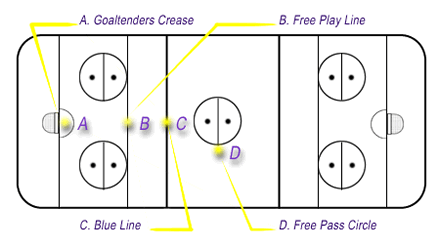Ringette is played on any standard hockey rink. Five skaters and a goalie are on the ice for each team. The object is to score goals on the net of your opponent. How you do that, however, is where Ringette becomes unique. A straight stick, similar to a hockey stick with no blade, is used to pass an 8" hollow rubber ring between teammates.
Teams have: 1 goalie, 1 center, 2 forwards, and 2 defense on the ice while full strength. A Free Pass would be taken from the shaded half of the Free Pass Circle, unless it is a Goalkeeper Ring in which the goalkeeper has five seconds to return the ring into play by throwing or using their stick to disribute it outside the crease. A Goalkeepers ring is used when there is infraction that would result in defensive possession. No player is allowed to be in the crease at any time during the game for protection of the goalies. A Goalkeepers Ring helps to keep the game flowing.
Play is started by a Free Pass, similar to the start of a soccer game. The ring is placed in the half of the center ice free pass circle closest to the visitors' goalie. On the referee's whistle, the player taking the free pass has five seconds to pass the ring to a team mate! Any stoppages in play will result in a free pass to re-start the game, usually in the nearest free pass circle.
Rules restrict any one player from carrying the ring the full length of the ice. The ring must be passed over each blue line to another player which means more players can be involved in setting up goals. It also cannot be passed the full length of the ice and a two line pass (the ring going over both blue lines) will result in the ring being taken back to the end it was passed from unless the other team gets possession of it before the team who passed it.
Free play lines define restricted areas in the deep offensive and defensive zones. Teams are allowed no more than 3 skaters at a time in these areas, so over-crowding is minimal. A wall of 5 skaters surrounding their goalie would make for little offensive opportunity, don't you think? There are exceptions to this rule, but only when two or more penalties are being served by one team or if the goalie has been pulled for an extra skater.
The shot clock was introduced last year in the Intermediate AA division and is becoming a part of Junior AA and up (in Alberta anyway) this year. It is a great new feature to the game and really enhances the speed and style of the play. 30 seconds are placed on the shot clock and the team with the ring must get it up the ice and take a shot, before it runs out. If possession is lost, or a shot is taken, 30 seconds are placed back up on the clock. This is a great addition to the game and has definitely change how it is played.
Most elite ringette players are amazing skaters. This mainly comes from the fact that Ringette is a non-contact game. Any body-checking will result in a penalty. The ring is usually checked away from a player by hitting the bottom third of the their stick with your stick. To be able to get in the right position to check ringette players have to use their strong skating and quick feet.
The equipment used for ringette is for the most part the same as for hockey. Skates, a helmet, a BNQ certified neck guard, shin pads, elbow pads, gloves, and pelvic protection are required. In ringette however we wear pants so a girdle (basically close fitting shorts with padding in them) is worn. Shoulder pads are optional because there is no body contact and the masks are a little different.
Ringette is a fast-paced highly intense sport that is fun to play and watch.
 |





